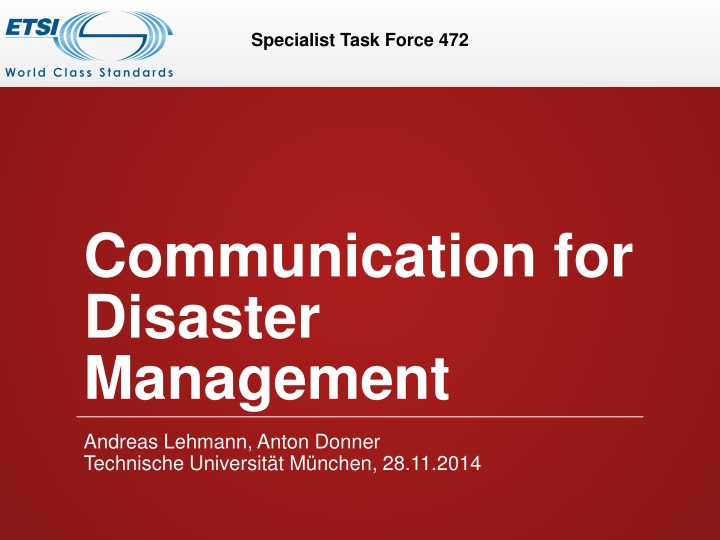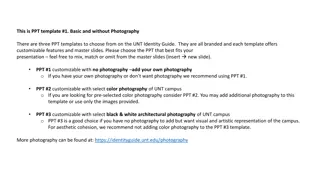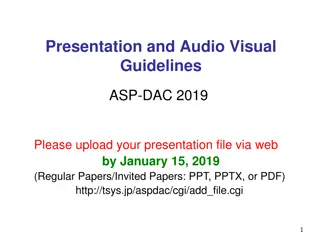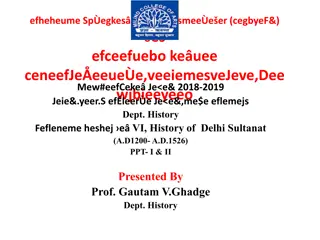
Communication Challenges and Solutions for Disaster Management
Explore communication challenges faced in disaster management and discover solutions for effective coordination and information sharing among emergency response entities. Learn about the role of Specialist Task Force 472 in enhancing communication for disaster management scenarios.
Download Presentation

Please find below an Image/Link to download the presentation.
The content on the website is provided AS IS for your information and personal use only. It may not be sold, licensed, or shared on other websites without obtaining consent from the author. If you encounter any issues during the download, it is possible that the publisher has removed the file from their server.
You are allowed to download the files provided on this website for personal or commercial use, subject to the condition that they are used lawfully. All files are the property of their respective owners.
The content on the website is provided AS IS for your information and personal use only. It may not be sold, licensed, or shared on other websites without obtaining consent from the author.
E N D
Presentation Transcript
Specialist Task Force 472 Communication for Disaster Management Andreas Lehmann, Anton Donner Technische Universit t M nchen, 28.11.2014
Andreas: Motivation Deployment examples etc. Specialist Task Force 472 Communication for Disaster Management
Outline Emergency management structure Actors and sectors Information flows Communication challenges Specialist Task Force 472 Communication for Disaster Management
Challenge Common Operating Picture Single display of information collected from and shared by more than one agency or organisation that contributes to a common understanding of a situation and its associated hazards and risks along with the position of resources and other overlays of information that support individual and collective decision making Scenario Investigation, Reports, Resources, Environment Source: Cabinet Office. UK Civil Protection Lexicon, Version 2.1.1, February 2013 Reality Transmission Assessment Abstraction Space Time Communication Channels Language Human Factor Decision Makers Common Operating Picture (incident commanders, emergency control centres, authorities, infrastructure) Specialist Task Force 472 Communication for Disaster Management
Off-Site (Inter-)National Resources Information Sources Infrastructure Assisting PSAPs/ECCs Public Safety Answering Point Service A, B, C Local Authority Individuals Emergency Control Centre Service A, B, C Emergency Task Force Alternative ECCs Information Exchange Private Mobile Radio (Voice) Fixed/Mobile Telephone (Voice) Private Mobile Data Fixed/Mobile Data Networks/Services Incident Area Coordinating Field Emergency Control Centre Incident Commander Sensors Service Incident Commanders Field Emergency Control Centres Services A, B, C Sector Cmdrs. Service A Sector Cmdrs. Service B Sector Emergency Control Centres Service A Sector Emergency Control Centres Service B (In-)Directly Affected Individuals Team Officers Service A Team Officers Service B Teams Service A Teams Service B Sector 1 Sector 2 Sector Not (yet) widely used PMR, trunked mode Fixed private network PMR, direct mode Public network
Mass Casualty Incident Management Individuals Triage I II III IV Authority/Task Force Information flow Public Safety Answering Pt./ Emergency Control Centre Optional Incident Area Field Emergency / Sector Control Centre(s) Holding Area Hazard Area Casualty Collection Point II Interim Care Centre Hospitals Transport I III IV I II III IV Speciality Clinics / Maximum Care Centres Immediate I Inner Cordon Unwounded, minor III Interim Shelter Shelter Outer Cordon Specialist Task Force 472 Communication for Disaster Management
Information Sharing Group calls (voice) simple and straightforward But what about data? Mobile and (quasi-)stationary devices, both on-site and off-site Unreliable wireless networks, both on-site and uplink to Internet Late join scenarios Radio cell hand-overs (inter-service, intra-service) Different roles with different tasks, but switching between roles is key requirement Data integrity and availability! etc. All data locally stored among all devices?!? Specialist Task Force 472 Communication for Disaster Management
1st Approach: Distributed Database Management System Star topology fixed network topology (core network segment) Bi-lateral synchronisation between nodes fixed node DB mobile node DB WLAN / WWAN DB DB fixed node fixed node mobile node WAN DB dynamic network topology DB mobile node Specialist Task Force 472 Communication for Disaster Management
Future Approaches: Fully Distributed, Fully Meshed? (Virtual) fully meshed topology With base station (see picture) or Ad hoc fixed node DB mobile node Problems DB WLAN / WWAN Service discovery DB Scalability Synchronisation efficiency mobile node WAN DB mobile node Specialist Task Force 472 Communication for Disaster Management



















